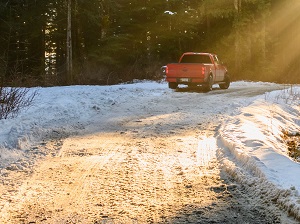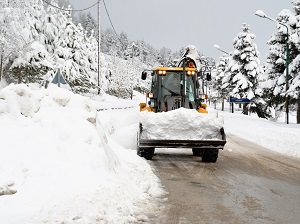As temperatures get lower, it's a good time to review winter hazard reminders and safety tips with construction crews working near or driving work vehicles or heavy equipment on the job site.
Each year, 24% of weather-related vehicle crashes occur on snowy, slushy or icy pavement, according to the US DOT.
Poor visibility and slick or slushy road conditions can make driving on and near the construction site or work zone unpredictable.
Depending on how low the temperatures get, and whether ice and snow are a concern on the job site, there are adjustments construction workers and heavy equipment operators can make to prevent driving incidents and injuries during the winter months.

Inspecting Vehicles and Equipment in Winter Conditions
Winter weather can take a toll on vehicles and equipment. It’s important to inspect all vehicles before use. Check vehicles at the beginning of each shift to ensure that the equipment is in safe operating condition. Clean, repair or replace anything not working properly prior to use or remove it from service. Allow vehicles and equipment to warm up, during cold weather, before use.
OSHA Standard 1926.601(b)(14) All vehicles in use shall be checked at the beginning of each shift to assure that the following parts, equipment, and accessories are in safe operating condition and free of apparent damage that could cause failure while in use: service brakes, including trailer brake connections; parking system (hand brake); emergency stopping system (brakes); tires; horn; steering mechanism; coupling devices; seat belts; operating controls; and safety devices. All defects shall be corrected before the vehicle is placed in service. These requirements also apply to equipment such as lights, reflectors, windshield wipers, defrosters, fire extinguishers, etc., where such equipment is necessary.

Managing Snow, Ice, and Visibility
Frost, ice, and condensation in cold weather can create blind spots and safety hazards. Sweep snow and ice from all parts of the vehicle including windows, mirrors, lights, wheel wells and the hood. Wait until all windows are fully defrosted before driving. Ensure windows, mirrors and lights on heavy equipment, trucks and work vehicles are kept clean and clear.
Worksite Visibility and Hazard Marking
Visibility can be a safety concern when working and driving on site during winter. Clean up the worksite before a snowfall to ensure hazards don’t get buried by the snow. If it starts snowing during the workday, find and mark any hazards that might be along a driving or walking path on the job site.
If driving near other traffic, a sudden slush or spray from other vehicles can cause a sudden loss of visibility. Prepare by reducing your speed, keeping your eyes on the road and your hands on the wheel.
Winter Clothing and PPE Considerations
All workers should be wearing high-visibility safety gear.

When working outdoors in cold weather, it’s important to dress warmly. Dressing in layers allows workers to remove outer wear more easily when moving from outdoors to indoors, including into and out of a climate-controlled cab.
Be aware of how your clothing affects your senses and adjust accordingly. Winter clothing should keep you warm but should not reduce your hearing, sight or “feel” for the equipment controls.
When inspecting heavy equipment, or when climbing in or out of a cab, wear insulated gloves in cold weather to ensure you don’t touch frozen metal surfaces with bare hands, which can cause serious tissue damage.
Preventing Slips, Trips, and Falls
Slips and falls are common when ice is a safety hazard on site. The effects of freezing and thawing at the job site when temperatures change can lead to dangerously slippery surfaces. Wear proper work boots with rough or heavy treads when working in wintry conditions to help prevent slips and falls. Be careful climbing into and out of any vehicle. Steps, grab holds, and grip plates may be slippery.

Winter Driving Safety Tips
Consider these driving safety tips and reminders when temperatures drop and snow, slush and ice are present on site.
- Follow at a safe distance because it takes longer to stop on a slippery road.
- Avoid sudden driving maneuvers like braking, turning or quickly accelerating. Ensure all driving moves in wintery weather are gentle and gradual to avoid spinning or skidding.
- If you begin to skid while driving, ease off the brake and accelerator and steer smoothly in the direction you want the vehicle to go until you can safely stop.
- Hard-packed snow on any road can be as slippery as ice.
- Wet snow can create heavy slush which can then build up in wheel wells and affect steering ability.
- In areas with more heavy equipment traffic, mud and snow can create ruts that can affect driving, depending on how deep they become.
- Slow down when approaching shaded areas, bridges and overpasses because these sections of road freeze sooner than others.
- On hills, pick a path that provides the most traction. Unpacked snow or powder provide a better grip.
Reporting Winter Hazards
Report concerns such as poor weather, vehicle and road conditions, or other job site dangers to your supervisor who can ensure all workers are aware of the hazards.


